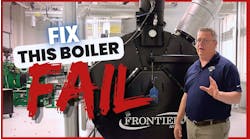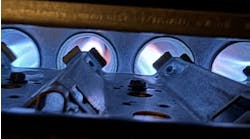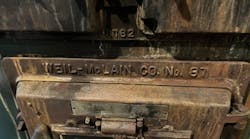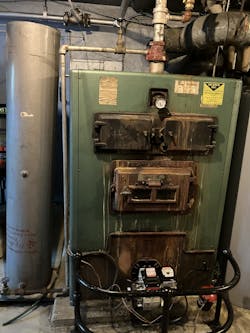Latest from Hydronics
Sponsored
Oil fired boilers are not very common in the Cincinnati market. The local gas company did a very good job of covering the major metropolitan market through the years. So I was surprised one day when I had two calls that each had oil-fired boilers.
The first call was in the heart of Cincinnati. It is an area that had a lot of commercial greenhouses back in the day. The navigation was taking me on a one lane road that was winding its way past the shells of abandoned greenhouses and the chimneys of the coal fired boilers that used to heat them.
The further I went, the more rural the landscape became, until the road came to an end. The view looked like a remote hollow in Kentucky, not five miles from downtown. The contractor came over to my car and said, “ It’s oil fired steam,” like he just found Sasquatch.
Conversion Pros and Cons
Up the hill was a brick house from the late 1800s, with an ancient steam boiler that was originally coal fired, piped to a one-pipe steam system added to heat the house in the early 1900s. The homeowner was interested in replacing the boiler because of a leak above the waterline, allowing steam to escape into the basement, rather than travel up to the radiators. He asked a lot of questions. I referred him to my Field Guide.
We discussed the merits of keeping it oil or putting in a propane boiler, since natural gas was probably a quarter mile away. The idea of converting the system from steam to hot water was also discussed, but with one pipe systems, a separate return piping system would have to be installed. That is a lot of labor, material and disruption to the home.
By the time we got away from the homeowner, the contractor admitted that his installation crew was down a couple of veterans and that he would be passing the job to one of my other customers. His guy that worked on oil had retired and his guy that did the piping was on injured reserve, probably indefinitely. I may be reporting more about this job at a later date.
Re-pipe Review
The photos in this column are from the second job. This one wasn’t in a valley, but high up on a ridge with great views. The local gas company hadn’t run a gas line up there back in the 1950s when the original five houses were built, but did run the line when twenty or so additional houses were added in the 1990s. This homeowner finally decided to hook up to gas this year.
The contractor wanted to review the re-piping that would be required to install the new high efficiency gas hot water boiler. The homeowner let us in, then left to go play golf. She wasn’t as interested in the process as the first homeowner. We went downstairs to take a look around.
The boiler is most likely original to the house, with a newer oil burner. This one looks like it was originally automatically oil-fired, although the boiler design is from the hand-fired coal days. That means extra-large cast iron sections with huge flue passages, kinda like the “new” three pass oil boilers that make cleaning so much easier. I especially liked the home made pipe guard around the oil burner
A Lot of Mass
There must be two tons of cast iron beneath that sheet metal jacket. That means that every time the boiler gets a call for heat, it has to warm up the cast iron before it can warm up the water. That’s a lot of mass. When it’s very cold outside, the cast iron stays pretty warm since the calls for heat come on a pretty regular basis. Operating efficiency is highest when the weather is coldest.
But when the weather is more moderate, which is the majority of the heating season around here, it takes a while to heat up two tons of metal, even with the hot fire of burning oil. Therefore, the standby loses are greater and the seasonal/operating efficiency goes down. How low depends on a few factors. With a flame retention burner, the efficiency doesn’t drop as much as with a gas atmospheric draft burner without a flue damper. The combustion air for that style boiler just drafts right up the chimney, cooling the cast iron sections between calls for heat.
Double-Check
I had forgotten how we originally estimated the size for the new boiler when I quoted this job a year ago. My memory is getting worse by the day. The size of the one on the quote seemed large, even for this large house. I asked the contractor the size of the oil nozzle and he immediately had an answer, but I asked him to actually check the one in the burner, since you don’t get many chances to be right about these things.
He didn’t have his tool bag with him, but reached into his pockets and amazingly pulled out an array of wrenches and whatnots. Within a minute he had the nozzle in his hand, a 2.25 gallon per hour. That was larger than the size he originally thought. Glad I asked.
One gallon of fuel oil roughly equals 140,000 btus of input, so this baby was using 315,000 btus of input to heat the home. The boiler I quoted inputs up to 400,000 btus, while the next size down inputs less than the 315,000. The contractor wanted to stick with the original size, although the output of the next size down is actually a bit more than what would be expected from the 2.25 nozzle.
I’m too old to argue about exact sizing anymore and with the modulating fire of the high efficiency boiler, the natural gas burner will input just what’s needed to warm up just one eighth of the mass of the original boiler to heat the water circulating through the system.
What Are We Looking At?
A few notes about what you see. That’s the expansion tank to the left of the boiler, standing on end. I see that every so often and wonder how the air separated by the dip tube air separator at the outlet of the boiler is going to float downhill to the tank. The original expansion tank was still in the ceiling, disconnected.
There is a weighted check valve in the supply main visible at the top of the picture, which was common for mid-century hot water jobs. The idea was to keep the heat in the boiler when the pump shut off, so the house wouldn’t overheat from gravity circulation. We use them now with multiple zone pumps to prevent circulation in the zones that aren’t calling for heat.
Patrick Linhardt is a forty-year veteran of the wholesale side of the hydronic industry who has been designing and troubleshooting steam and hot water heating systems, pumps and controls on an almost daily basis. An educator and author, he is currently Hydronic Manager at the Corken Steel Products Co.
Patrick Linhardt
Patrick Linhardt is a forty-one-year veteran of the wholesale side of the hydronic industry who has been designing and troubleshooting steam and hot water heating systems, pumps and controls on an almost daily basis. An educator and author, he is currently Hydronic Manager at the Corken Steel Products Co.



